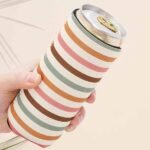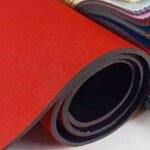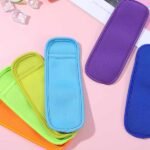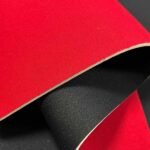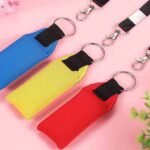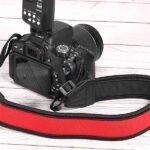Neoprene koozies are more than fun drink accessories—they’re a customizable branding powerhouse for events, giveaways, and promotional merchandise. From beach parties to trade shows, custom neoprene koozies allow businesses and brands to showcase their logo in a highly tactile, reusable format. But if you’re sourcing from a manufacturer like Szoneier and want to customize your koozie with precision, the printing method you choose can make or break the result.
Neoprene koozies can be printed using screen printing, sublimation, heat transfer, or thermal press methods. The best choice depends on your design, colors, budget, and order volume.
While neoprene’s soft, flexible surface is ideal for insulating beverages, it also presents challenges when it comes to printing. Ink absorption, fabric texture, and color contrast all behave differently than on flat cotton or polyester. That’s why understanding the available printing techniques is crucial for buyers planning OEM or private label production.
We once helped a US-based microbrewery select sublimation printing over screen printing for a short-run of koozies with full-color artwork. The brewery’s decision was driven by vivid branding goals and quick delivery timelines—and the result was a flawless batch that sold out in two weeks.
In this article, we’ll walk through each printing process for neoprene koozies and help you decide which one works best for your unique use case.
What Makes Neoprene Koozies Ideal for Custom Printing?

Neoprene’s insulation, flexibility, and smooth surface make it excellent for custom printing—especially for promotional or private label koozies with logos or artwork.
Neoprene is a synthetic rubber material known for its flexibility, durability, and insulating properties. It’s often used in wetsuits, laptop sleeves, and protective cases. For koozies, neoprene provides:
- Excellent insulation to keep beverages cold
- Soft, grippy texture that conforms to cans and bottles
- Stretchable surface for easy application and snug fit
- Durable structure that withstands repeated handling
From a printing perspective, neoprene is well-suited for:
- Flat designs that require moderate ink penetration
- Vibrant colors when paired with white or coated polyester surfaces
- Custom logos that remain intact despite flexing
However, the porous and flexible nature of neoprene means that not all printing methods work equally well. Ink may bleed or crack if not properly bonded, and color vibrancy can fade if the substrate isn’t prepared correctly. That’s why material preparation—such as heat pressing the surface or pre-coating with polyester—is key to achieving professional-grade results.
Which Printing Techniques Are Commonly Used on Neoprene Koozies?

Common printing methods for neoprene koozies include screen printing, sublimation, heat transfer, and thermal press—each suited to different design needs.
Let’s break down the most popular methods used by manufacturers:
| Method | Best For | Key Advantages | Limitations |
|---|---|---|---|
| Screen Printing | 1-3 color logos, bold text | Low cost, durable, vibrant on dark colors | Limited to fewer colors & sharp edges |
| Sublimation | Full-color art, gradients, photo prints | Vivid colors, great for polyester-coated neoprene | Requires white base; best on light backgrounds |
| Heat Transfer | Small batches, multicolor designs | Low MOQ, flexible, clear finish | Slightly higher cost per unit |
| Thermal Press | Vinyl-based lettering or logos | Precise shapes, no bleeding | Feels raised, not suitable for full coverage |
At Szoneier, we offer all four methods in-house. Clients can request samples using different techniques to compare finish quality before proceeding to bulk production.
How Does Screen Printing Work on Neoprene Koozies?

Screen printing on neoprene involves layering ink through a stencil mesh to apply bold, solid-color logos or text onto flat areas of the sleeve.
Screen printing is one of the most traditional and economical printing techniques used in koozie manufacturing. Here’s how it works:
- A mesh screen is prepared with a stencil of the desired logo/design.
- Neoprene sleeves are placed on a flat printing table or form.
- Ink is spread over the screen using a squeegee, transferring the design.
- The printed sleeve is heat cured to bond the ink to the material.
Why use screen printing?
- It works well for high-volume runs.
- Ideal for simple, bold logos with few colors.
- Inks are durable and vivid, especially on dark neoprene.
However, screen printing has limitations:
- Difficult to execute complex gradients or fine details.
- Not cost-effective for multicolor prints under 300 pcs.
That said, for a promotional campaign or a standard OEM logo, it remains the go-to solution.
Is Sublimation Printing Suitable for All Neoprene Koozies?

Sublimation printing works best on white polyester-coated neoprene koozies, producing full-color, high-resolution designs with lasting vibrancy.
Sublimation is a heat-based printing method that turns solid dye into gas without passing through a liquid phase. It chemically bonds the ink into the fabric fibers, rather than sitting on the surface.
Here’s the process:
- Design is printed on sublimation paper using special inks.
- The image is placed on the koozie and heated to 190–200°C.
- Heat and pressure cause the ink to penetrate the polyester layer.
This process results in:
- Photo-quality detail
- No raised feel—it becomes part of the neoprene
- Resistant to cracking or fading
But sublimation only works if:
- The neoprene has a white polyester top layer
- The design is intended for light backgrounds
Szoneier’s production line includes sublimation-compatible neoprene stock with coated surfaces specifically for this purpose.
What Is the Difference Between Heat Transfer and Sublimation on Neoprene?
Heat transfer applies a printed film to the surface, while sublimation embeds dye into the material—each with unique texture, durability, and color vibrancy.
Heat transfer and sublimation may both use heat, but they serve very different purposes:
Heat Transfer:
- Transfers a design (on film or vinyl) using heat and pressure.
- Works on dark or colored neoprene without a white base.
- Slightly raised texture depending on material.
- Good for short runs or intricate designs.
Sublimation:
- Requires a white polyester surface.
- No texture—ink fuses into the material.
- Best for vibrant, high-resolution images.
Use case comparison:
- Corporate logos in bold colors → Heat transfer
- Full-wrap photo-quality branding → Sublimation
At Szoneier, we help OEM buyers choose the correct method based on logo layout, material surface, cost per unit, and timeline.
Do Custom Logos or Multi-Color Designs Affect the Printing Process Choice?
Yes—logos with multiple colors, fine details, or large surface coverage may require sublimation or heat transfer, while simple logos are ideal for screen printing.
Different logo characteristics demand different print strategies:
- 1-2 solid colors, blocky text → Screen printing
- Full-color gradients, photography → Sublimation
- Metallic logos, custom shapes → Thermal or vinyl press
In general:
- The more detailed or colorful the design, the less suitable screen printing becomes.
- Sublimation or heat transfer can preserve detail but may increase cost.
Need to print multiple variants (e.g. different colors for different markets)? Heat transfer allows quick changeovers with digital file swapping—ideal for seasonal or regional marketing.
Szoneier’s design team reviews artwork and mockups to suggest the most efficient, high-impact printing approach before you commit to production.
How to Choose the Best Printing Method for OEM or Private Label Koozie Orders?
Start by reviewing your design complexity, color needs, volume, and material surface. Choose screen print for simplicity, sublimation for impact, or transfer for flexibility.
There’s no one-size-fits-all. Your print method depends on a blend of factors:
| Factor | Best Print Method |
|---|---|
| 1-2 Color Logo | Screen Printing |
| Full-Color Graphics | Sublimation |
| Small Quantity Run | Heat Transfer or Thermal Press |
| Dark Neoprene Base | Heat Transfer or Screen |
| Photo-Quality Need | Sublimation |
Pro Tips for OEM Buyers:
- Screen printing costs drop significantly at high volumes (>500 pcs).
- Sublimation ensures premium brand appearance—great for gifts and influencers.
- Heat transfer suits short, flexible orders with seasonal artwork.
At Szoneier, we help global clients choose the most effective printing process for their custom neoprene koozie projects—whether you’re ordering 100 or 10,000 units.
Conclusion: Let Szoneier Print Your Custom Neoprene Koozies
Choosing the right printing method for neoprene koozies is critical to brand impact, product durability, and cost control. From budget-friendly screen prints to premium sublimation artwork, each method brings unique strengths.
With over 18 years of experience in neoprene R&D and manufacturing, Szoneier offers:
- OEM, ODM & private label koozie services
- Multiple printing options in-house
- Free design support and sampling
- Fast turnaround and low MOQs
Get in touch today for a free consultation or sample quote.


